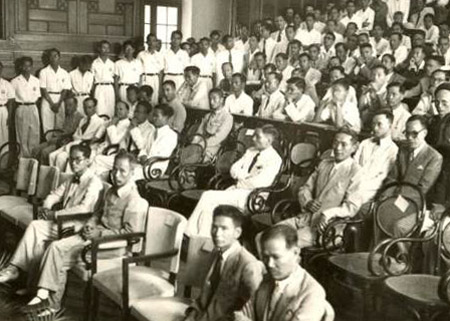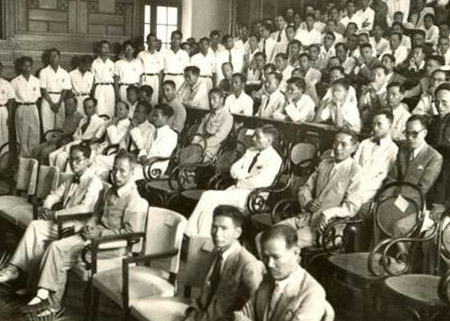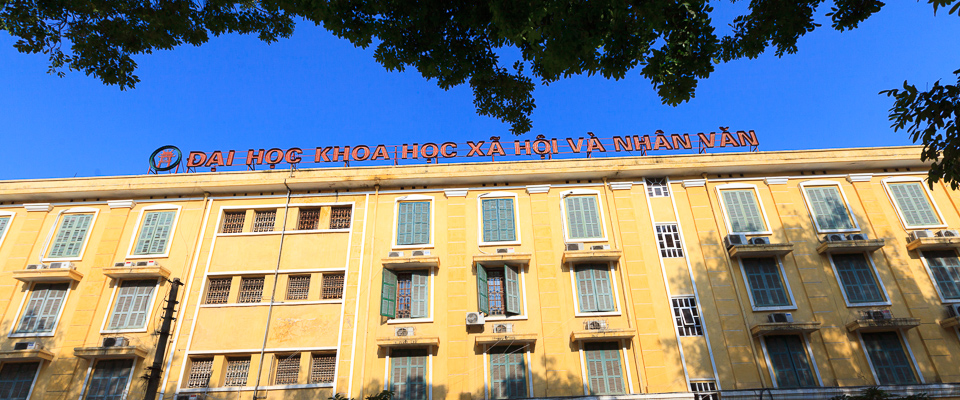
As we enter a new era, the entire nation must face new and extremely serious challenges.
The historical responsibility of dealing with internal and external enemies, maintaining the revolutionary government, and maintaining the nation's independence and freedom rested on the shoulders of the Government with Ho Chi Minh as President.
DirectiveResistance war and national constructionThe Central Party Standing Committee stated: The Vietnamese Revolution at this time is still a national liberation revolution. The slogan is still: Nation above all! Fatherland above all!
President Ho Chi Minh pointed out: to maintain independence and freedom, we must strongly promote national motivation on the foundation of a new regime and new people.Resistance must go hand in hand with nation building. To build a nation, we must have talented people.Under French colonial rule, more than 90% of our people were illiterate. Talents in the country were also very rare.
To eliminate the consequences of the French colonialists' policy of keeping people ignorant and to improve people's knowledge, train the young generation, the future owners of the country, and nurture talents, the Government has stepped up the task of fighting illiteracy, opening schools from primary to college level, preparing a program to reform the old education system, and gradually building a new democratic national education.
The Government, especially President Ho Chi Minh, attached great importance to the task of education at the university level to train talents to serve the resistance war and national construction. The Government decided to inherit and reform the old universities and colleges opened by the French in Hanoi.[1], we have just won the right to control and develop a number of new universities to create a democratic national college and university education system for the independent and free Vietnam. The meetings of the Government Council on September 22, October 4, October 8, October 31 and November 8, 1945, consecutively discussed the policy of opening old universities and colleges and establishing new universities.
The country had just gained independence and freedom, many students and young people wanted to leave universities and colleges to go to agencies and battlefields to directly serve the resistance and national construction tasks. However, with the country's need to train talented people, the Government Council decided to immediately open colleges and universities. Under the Government's order, on October 8, 1945, Minister of National Education Vu Dinh Hoe signed a Decree, announcing that from November 15, 1945, universities and colleges would open in Hanoi, including the following schools: University of Medicine, Pharmacy, Dentistry, College of Science, College of Fine Arts, College of Agriculture, College of Veterinary Medicine, to welcome students back to school. The Government established the University Affairs Department with Nguyen Van Huyen as Deputy Director to directly manage the University and College Sector. Universities were entitled to establish autonomous funds according to Decree No. 43/SL. Vietnamese is used for teaching at universities and colleges. The selection and appointment of directors, professors and lecturers are also discussed by the Government, including if necessary, inviting foreign professors to teach and determining the salary policy of professors and lecturers.
In the French colonial university system, the University of Letters (Social Sciences and Humanities) was not established. With a correct vision of the important role of social sciences and humanities in the social life of an independent nation, on October 10, 1945, President Ho Chi Minh signed Decree No. 45/SL to establishFaculty of Letters, University[2] in Hanoi, directed by Professor Dang Thai Mai, a revolutionary scholar with profound knowledge of ancient and modern cultures, East and West. The Faculty of Literature of Hanoi University has the task of training high school literature professors and improving Vietnamese literature to be worthy of an independent country to keep up with advanced countries around the world.
The Faculty of Letters of Hanoi University has the departments of Philosophy, Vietnamese Studies, Sinology, History, and Geography. After graduation, students are awarded the Bachelor of Letters (Bachelor). The school also trains and awards Master's degrees and can organize courses to take exams for Doctor of Letters (PhD). Regulations on study programs, teaching, graduation exams, defense of Doctor of Letters, and awarding of graduation degrees are scientifically and strictly regulated in the Decree of the Minister of National Education dated November 3, 1945. The old Law University had to be reformed. However, considering the immediate need at that time, the Government decided to open a temporary College of Politics and Society at the University of Letters, headed by a Secretary General. The College of Politics and Society has the task of training, over a period of two years, professionals who can be appointed as senior officials in the Ministry of Foreign Affairs and in national administrative agencies. The Government appointed Mr. Cao Xuan Huy, Dang Thai Mai, Nguyen Manh Tuong, Ho Huu Tuong, Nguyen Van Huyen, Nguyen Duc Nguyen as professors in the Faculty of Literature of the University and Mr. Dao Duy Anh, Cu Huy Can, Tran Van Giap, Ngo Xuan Dieu, Tran Khanh Giu, Pham Duy Khiem, Bui Ky, Nguyen Dinh Thi and Doan Phu Tu to teach special issues in the Faculty of Literature program. The University Director will negotiate with the above-mentioned people about the teaching issues and the number of hours that they will teach in the 1945-1946 school year. For the Social Politics class, in addition to legal scholars, philosophers, writers, historians, the Ministry of National Education also planned to invite political activists to teach, among them Ho Chi Minh and Pham Van Dong will teach about the Constitution, Vo Nguyen Giap will teach about Economics...
President Ho Chi Minh's decision to establish the University of Letters under Decree No. 45/SL dated October 10, 1945 wasa major eventmarking a historical milestone in the establishment of the University of Humanities, now the University of Social Sciences and Humanities, Vietnam.

Opening Ceremony of the first University of the Democratic Republic of Vietnam, President Ho Chi Minh and Minister Nguyen Dinh Hoe sat in the first row, in the middle
Implementing the Government's policy, on November 15, 1945, at the Indochina University campus at 19 Le Thanh Tong, Hanoi, the opening ceremony of the first course of the Vietnam University under the democratic republic regime was held. President Ho Chi Minh presided over the ceremony, and a number of international guests also attended. Director of the University Affairs Nguyen Van Huyen read the opening speech. Minister of National Education Vu Dinh Hoe presented the tasks of the Vietnam University in the new period.
The opening ceremony of Vietnam University on November 15, 1945 included 5 faculties: Medicine, Science, Literature, Social Politics and Fine Arts. The Faculty of Literature was completely new. The purpose of this faculty was to train a number of high school professors and a number of young people with solid knowledge to participate in research and invention of philosophy, society, literature, history, geography to contribute to the cultural construction of humanity as Director Nguyen Van Huyen presented in his speech at the opening ceremony.
The opening of the Universities in Hanoi was an opportunity for professors and students to show the world that in the critical time of the Fatherland's future at that time, "the Vietnamese people, in addition to the bloody struggle on the battlefield, also made efforts to participate in the progress of human culture. We want this new university to be a strong force among the fighting forces of the Vietnamese people. We want it to be a stronghold for the long-term resistance to completely restore the territory and liberate the spirit of the nation. We are a civilized people with a thousand years of independent history and have created a unique civilization on this Pacific coast."[3]
The birth of Vietnamese universities right after the successful August Revolution brought to professors and students of universities at that time a deep pride in a university of an independent and free Vietnam and was a great motivation for professors and students to raise their determination to build a national university and be ready to enter the extremely arduous challenge of the resistance war and national construction.
With that meaning, the opening ceremony on November 15, 1945 wasopening a new erafor Vietnamese universities
Thus, starting from the first school year after the August Revolution, Vietnam’s education system has undergone a comprehensive change in organization and nature. All levels of education after the opening have been taught and studied well with the consciousness of serving the Fatherland. At the university level, the Faculty of Letters has 253 students and the Department of Social Politics has 52 students. All universities have 1,149 official students and 270 auditors.[4]On October 11, 1946, the Government issued Decree No. 197/SL, deciding to open a Legal Department at Vietnam University.
Evaluating the organization and operation of Vietnam's education system in the first year under the new regime, President Ho Chi Minh said: "We have done a lot in education, much better than the French."[5]
In December 1946, the national resistance war broke out. All universities moved to the liberated areas. The resistance war was fierce and fierce, some universities temporarily reduced the scale of training or suspended training for a period of time.
Universities continued to train on an appropriate scale such as the University of Medicine and the University of Pharmacy (1947), the College of Public Works and Transport (1948). The University of Law was re-established in early 1949, and the following year the school was divided into the Faculty of Law and the Faculty of Economics. The College of Fine Arts was re-established in the 1949-1950 school year...
The University of Science opened a re-teaching introductory mathematics class in Inter-zone IV in the 1947-1948 school year and continued to open in the 1948-1949 school year. In the North, from the 1948-1949 school year, an introductory mathematics class was opened and then merged into the Pedagogical Department of the University of Science.
A University Pedagogy Department was also opened at the University of Literature and the University of Science in the 1948-1949 school year to train secondary school teachers specializing in literature and science.
The Ministry of National Education has reformed the system of teacher training schools to improve the quality of teacher training, meeting the requirements of educational reform. Decree No. 234/ND (October 1, 1951) decided to establish the Central Campus including 3 schools: School of Basic Sciences, School of Advanced Pedagogy, Central Intermediate Pedagogy School. The campus is under the direct control of the Ministry. Next, the Ministry issued Decree No. 276/ND (October 11, 1951) to abolish the Science University Pedagogy Board and establish the Advanced Pedagogy School to train high school teachers for general schools, including 3 departments: Mathematics, Physics, Chemistry, and Physics;Decree No. 277/ND (October 11, 1951),opened one-year University Preparatory classes at the beginning of the 1952 school year in Inter-zone 4, including two departments: Social Sciences Department (subjects: Philosophy and Politics, Vietnamese Literature, Foreign Languages, World Literature History, History, Geography, Economics) and Natural Sciences Department (subjects: Mathematics, Physics, Chemistry, Physics). The programs of these two departments were trained at the first year university level to serve the rapidly developing resistance war. The first class (1952) had about 200 students. The University Preparatory classes were under the direct control of the Ministry.
At the same time, with the policy of reforming the entire general education system, replacing the old education system with a 9-year general education system, continuing to re-educate a number of universities, the Government sent cadres and high school graduates to study abroad, proactively preparing for the country's construction after the victory of the resistance war.
In the fierce war conditions, the battlefield was divided, the free zones were often attacked by the enemy, the Party and the Government still attached importance to developing a new national and scientific education to improve the cultural and educational level of the nation, continuing to maintain college and university education, including the University of Science and the University of Literature to train teachers for high schools and scientific staff to research natural sciences and social sciences.
The achievements in general higher education, of natural and social science universities during this period, although limited, were of special importance, not only serving the resistance war against French colonialism, but also laying a solid foundation for the Government of the Democratic Republic of Vietnam to build large and core universities of the national and modern Vietnamese university system on a large scale to serve the cause of building the socialist North and the resistance war against the US to save the country later.
After the North was liberated (1954), entering a period of economic recovery and cultural development gradually moving forward along the socialist path, the Party and the Government continued to consolidate and develop major universities in Hanoi. On June 4, 1956, the Government issued Decree No. 2183 establishing 5 major universities and 15 vocational high schools, including Hanoi University of Science. On September 14, 1956, the Minister of Education issued a Decision appointing Professor Nguy Nhu Kon Tum as Director and Professor Dang Thai Mai as Head of the Faculty of Literature and History.

Former Hanoi University of Science (19 Le Thanh Tong, Hanoi today)
Hanoi National University is a basic science university established on the basis of the University of Science and the University of Literature.[6]
On December 10, 1993, the Government issued a Decree to establish Hanoi National University on the basis of rearranging and reorganizing a number of universities and research institutes in the Hanoi area. Hanoi University of Science, Hanoi Pedagogical University and Hanoi University of Foreign Languages. Hanoi University of Science was divided into two schools: University of Natural Sciences and University of Social Sciences and Humanities.

University of Social Sciences and Humanities, VNU today
The University of Social Sciences and Humanities is the continuation and development to a new step of the tradition of the University of Literature founded by Ho Chi Minh on October 10, 1945, of the Faculty of Literature, the Faculty of History and other faculties of social sciences established in the following years.
Looking back at the process of birth, development and contribution of the University of Literature, now the University of Social Sciences and Humanities, to the cause of resistance and nation building, maintaining and developing the Democratic Republic, now the Socialist Republic of Vietnam, helps us clearly see the strategic vision of the role of social sciences and humanities in the political and social life of the country of President Ho Chi Minh - an outstanding cultural figure of the nation, who very early "from Nguyen Ai Quoc radiated a culture, not European culture, but perhaps a future culture" as O. Mandenxtam wrote in the Ogoniok newspaper (Soviet Union) No. 39, December 23, 1923.[7]The culture of Nguyen Ai Quoc - Ho Chi Minh is the dialectical assimilation and synthesis of the cultural values of the Vietnamese people and the culture of humanity to develop and enrich the culture of the Vietnamese people.
[1]It was not until May 1906 that Governor General of Indochina Paul Beaurushsigned a decree to establish in Indochina under the name of university, a set of university training blocks for the colony and neighboring countries to disseminate in Indochina through French about economic knowledge, scientific administration to serve the French domination in Indochina. Because of passivity and haste, it was not until 1907 that the school opened and 94 people enrolled. The actual number of students was only 41. By 1939, Indochina universities had 730 students. The general policy of keeping people ignorant, the restriction of general education, especially university education was a sinister method of French colonialism to easily enslave our people.
[2]Faculty of Letters, which is the University of Letters, now the University of Social Sciences and Humanities.
[3]Nguyen Van Huyen: "Speech delivered at the opening ceremony of Vietnam University on November 15, 1945", Nhan Dan Newspaper.
[4]Minutes of the Government Council in 1945. Documents of the National Archives Center III.
[5]Minutes of the Government Council in 1945. Documents of the National Archives Center III.
[6]The University of Science (Natural) was established in 1941 - then called the College of Science, and the University of Literature was established on October 10, 1945.
[7] Ho Chi Minh Complete Works,CTQG, H, 1995, Vol. 1, p. 478.
Author:Associate Professor Le Mau Han